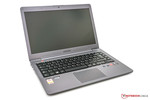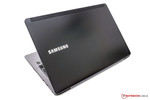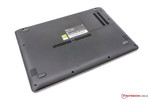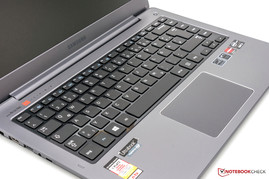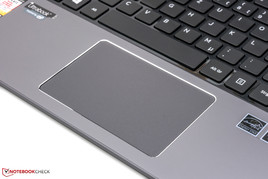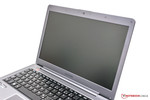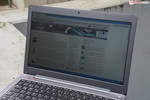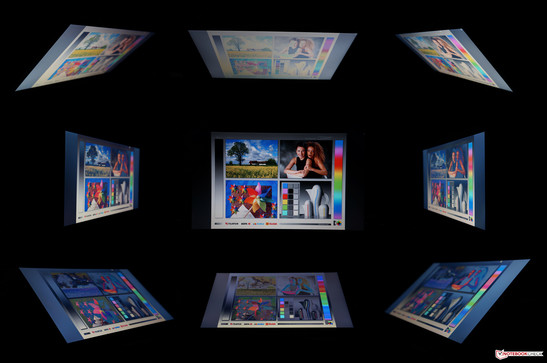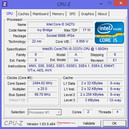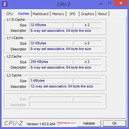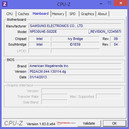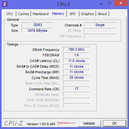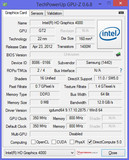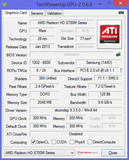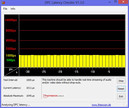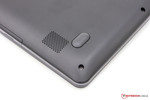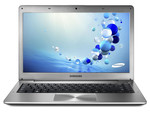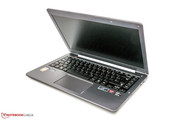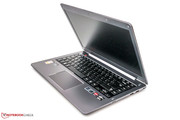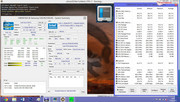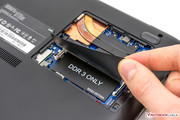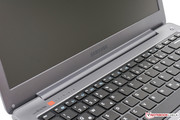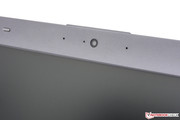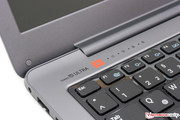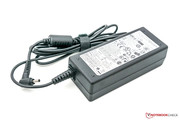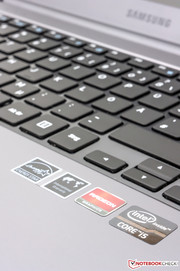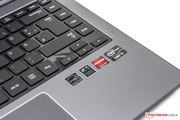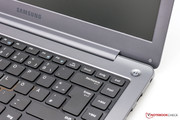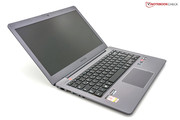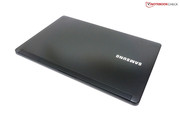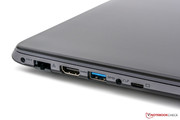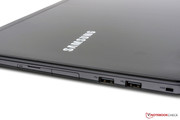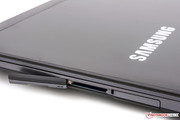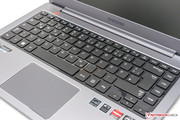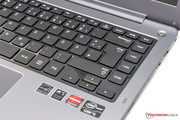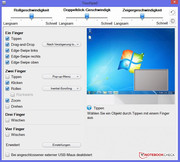Review Samsung Series 5 530U4E-S02DE Ultrabook

For the original German review, see here.
Ultrabooks beyond 1000 Euros (~$1292) are often encountered when looking around for a new device, as these are apparently more frequently advertised. Samsung's premium models are found in the Series 7 Ultra and Series 9. Nevertheless, the Series 5 midrange models should not be neglected. It is just this range that Samsung has now renewed. Not only the hardware has been updated this time, but the design is fresh and differs visibly from the predecessors. Samsung relies on understatement.
The model 530U4E-S02DE that we are testing features a matte, 14-inch screen with a resolution of 1366x768 pixels. Intel's Core i5-3337U dual-core processor (ULV) with 1.8 GHz, 4 GB of working memory alongside a 500 GB hard drive and 24 GB Express Cache work under the hood. The likely most striking feature is the dedicated AMD Radeon HD 8750M graphics unit with a 2 GB memory and a core clock of 825 MHz. The company names our test device "Multimedia Ultrabook" for exactly this reason.
We will closely examine the refresh of the series in this review. Is the new chassis convincing, how much power do the components provide and what good are the extras like the stereo speakers featuring a JBL logo? The answers can be found in the course of this review.
Case
The first impression is vital and the new Series 5 makes a good one. The casing is now much subtler. The general styling looks more straightforward. In contrast to the prior 530U4C, the display lid is deep black. The cover made of brushed aluminum also conveys a pleasantly cool feel. The rest of the chassis is comprised of plastic, which is not a disadvantage by itself. The ultrabook's base, for example, has a matte finish that also feels compelling.
The plain impression is continued inside. However, an all-over gray color alongside a high-gloss keyboard background dominates here. This looks stylish, but is a small drawback in our opinion. The piano paint finish underneath the keys is considerably more sensitive than the other, matte components. The workmanship makes a good impression. All gaps are equally spaced. Even the transitions between the single parts do not give reason for complaint. Naturally, stiffness is a crucial factor. The casing's lower part seems rigid. It only yields when high force is applied using both hands. The display lid is stiff. No visible waves are produced on the screen when pressure is applied.
With a size of 38.8 x 23.4 x 1.95 centimeters (w x d x h), the 530U4E weighs approximately 1.8 kilograms. It is not a lightweight but not heavy either. Devices like Apple's MacBook Air 13 or Asus' Zenbook Prime UX31A have an average weight ranging from 1.3 to 1.5 kilograms. Lenovo's ThinkPad X1 Carbon Touch is roughly 300 grams lighter with the same screen size (1.5 kilograms). Toshiba's Portégé Z930-105 is very light with 1100 grams.
Connectivity
It is all come and go on the ultrabooks' side. We used the 530U4C-S02DE (being the direct precursor) for comparison.
We find a total of three USB ports. However, only one meets the 3.0 standard. The former model sported two of these ports. A step backward. The DVD drive and the VGA out have also been omitted. However, this is not a tragedy in our opinion. Older VGA monitors or projectors can still be used via a special adapter (price: approx. 25 Euros, ~$32). It is connected via a space-saving port. The adapter for this is not included. Other interfaces are an HDMI out, RJ45, audio jack, SD card reader and a Kensington lock. We generally find the ports' rear positioning on the new model better.
Communication
Samsung installs all modern communication standards. Realtek's PCIe GBE Family module takes care of cabled data distribution. Wireless connections are performed with the integrated Intel Centrino Advanced-N 6235 chip, which supports Wi-Fi 802.11 a/b/g/n and Bluetooth 4.0. The indoor reception performance is excellent. The outdoor performance is good (15 meters: 50%) to satisfactory (40 meters). This component also enables using Intel's Wireless Display Technology (WiDi). It allows transmitting data to external monitors without cables. A compatible device or special receiver is needed for this.
Accessories
Only the essentials for immediate use are found in the box. Besides the ultrabook, Samsung only includes the matching power supply with power cord and printed documentation. But we did not expect more for this device.
Maintenance
The base of the 530U4E is rather sealed. Only the empty RAM slot can be accessed via a small maintenance cover. A DDR3 module (1600 MHz) with a capacity of 8 GB can theoretically be installed. The other components can only be accessed after disassembling the base plate. Besides a few screws, the plastic hooks are particularly annoying. They break extremely fast and the casing might not close properly. Therefore, this is a case for an expert. We are naturally not liable for any such attempts.
However, that is not uninteresting in view of performance and maintenance. For one thing, the 500 GB hard drive could be exchanged for a swift solid state drive (SSD). For another, the fan could be cleaned although this will certainly be unnecessary within the first 12 months.
Warranty
Samsung includes a 24 month warranty on the ultrabook ex-factory. This service can be upgraded to 36 or 48 months for a surcharge. The company does not state any recommended retail prices for these upgrades.
Input Devices
Keyboard
Samsung still uses a chiclet keyboard for text inputs, as we already know from the 530U4C. The layout is generous although an additional key column has been implemented at the right. This is obstructive particularly at the beginning in view of ergonomics. Our editor would not miss it. The keys' lightly rubber-coated surface and the low noise development are agreeable. The pressure point is clear and results in a pleasant typing feel. Apart from this convincing performance, we would appreciate a backlit keyboard in future.
Touchpad
A big touchpad lacking dedicated mouse buttons has been integrated below the keyboard. It is an Elan Smart-Pad that can be modified to a great extent in the system settings. Besides various multi-touch gestures, special Windows 8 swipe gestures are supported that are implemented with a finger from the touchpad's edge. The tool includes many videos with examples for this. The very good implementation of gestures even appealed to a user of a MacBook with a glass trackpad. The gliding traits make a good impression. The entire surface can be used as a left mouse button. As usual, the second mouse button is at the lower right.
Display
The laptop displays content on a matte, 14-inch screen, i.e. a diagonal of 35.56 centimeters. A native resolution of 1366x768 pixels can be reproduced in an aspect ratio of 16:9 on this area. The screen model AUO313C is supplied and not made by Samsung. It is a TN screen with an LED backlight. Samsung of course does not offer a higher resolution option with 1920x1080 pixels (Full HD, 1080p) for this price. External monitors or televisions can be connected via the HDMI out without losses. This port also transmits the audio signal.
We first ascertained the screen's available brightness using the X-Rite i1Pro 2 tool. An average of 175 cd/m² resulted from nine measuring points and places the screen in only the lower midfield. The precursor's screen scored much higher with a rate of 320 cd/m². Another point of criticism is the fluctuating illumination. The screen only achieved 81% with a maximum difference of 36 cd/m². This difference is not visible in routine use.
| |||||||||||||||||||||||||
Brightness Distribution: 81 %
Center on Battery: 190 cd/m²
Contrast: 485:1 (Black: 0.39 cd/m²)
45.07% AdobeRGB 1998 (Argyll 3D)
63.5% sRGB (Argyll 3D)
43.64% Display P3 (Argyll 3D)
The other rates are acceptable but confirm the middling impression. The black value of 0.39 cd/m² is low. The contrast ratio of 485:1 remains behind its possibilities due to the weak LED light. Our subjective impression confirms the rates. Furthermore, the colors look comparatively pale. The matte surface contributes to this as well. We finally checked the color gamut for professional users. The sRGB reference does not come close to being covered. Thus, this ultrabook is not the right tool for photographers. Minor differences usually become apparent in a comparison with similar configurations.
The screen's matte surface is a good precondition for outdoor use. However, experience shows that this is not the sole requirement for its success. The brightness and contrast also have to be right. The brightness is too low and the contrast too weak in the case of our test device. The device can basically be used outdoors, but working in bright ambient light is restricted.
A partly high viewing angle dependency results from the use of a TN screen. The reference picture is well-legible from the side horizontally. However, a slight deviation from the ideal vertically is enough to let the content invert or fade. High-quality laptop screens based on IPS technology do not have problems in this context. Then again, this technology is also noticed in the price.
Performance
The 530U4C-S02DE we are testing is currently the only new model of the Series 5 featuring a 14-inch screen. The key component is Intel's Core i5-3337U dual-core processor (2 cores, 4 threads). This chip is an ultra-low voltage model (ULV) that has been specially designed for the ultrabook device category. The processor works with a default clock of 1.8 GHz. Up to 2.7 GHz on one core is possible via Turbo Boost during load. It is a maximum of 2.5 GHz in dual-core operation. The i5-3337U we are testing is the successor of the formerly often used Intel Core i5-3317U. It is based on Ivy Bridge architecture with a structure width of 22 nm and a 3 MB L3 cache.
In addition to the integrated GMA 4000 HD graphics unit, Samsung's ultrabook also sports a dedicated GPU. AMD's Radeon HD 8750M clocks with a core rate of 825 MHz, is based on the GCN architecture (28 nanometers), offers 2 GB of memory and is aimed at casual gamers who need a stronger graphics card than the one integrated. The GPU supports DirectX 11.1, Shader 5.0 and automatic graphics switching. Thus, the processor-integrated GPU is automatically enabled for more basic tasks. Detailed information about the 8750M can be found in our tech article for this graphics unit.
The other configuration ex-factory consists of a 4 GB DDR3 RAM (1600 MHz), a 500 GB hard drive and a small 24 GB solid state drive. This is to particularly speed up booting and opening programs. The working memory can easily be upgraded to maximum 12 GB via a small maintenance cover. As mentioned earlier, the hard drive can also be replaced but this should not be done by non-professionals.
Processor
We used various benchmarks to test the performance of Intel's Core i5-3337U. We started with the older Cinebench R10 64 bit multi-thread calculation. All four threads of the CPU are active in this test. A score of 9122 points was achieved. Thus, the processor is slightly better or on a par with Intel's Core i5-3317U depending on the terminal. Toshiba's Portégé Z930 is in the immediate vicinity with 9158 points. Overall, both CPUs are in the lower midfield of our database.
The latest Cinebench R11.5 confirmed the CPU's performance. However, the i5-3337U's slightly higher performance becomes evident. The ultrabook sets itself apart from configurations featuring an i5-3317U with 2.48 points in the multi-CPU calculation. Asus' VivoBook S400CA scores 3% lower with 2.41 points. However, the difference between both chips will not be noticed during routine use. Samsung currently does not offer a model with a faster CPU. However, Intel's new Core i7-3537U with 2 GHz would be imaginable in this context. Intel's Core i7-3517U predecessor averagely achieved 10583 points in this benchmark (14% difference).
We naturally checked the system for potential throttling during load using the tools Prime95 (CPU) and Furmark (GPU). We did not ascertain any problems after a runtime of over an hour. Both the CPU and the dedicated GPU from AMD ran stably without a decrease in performance.
| Cinebench R11.5 - CPU Multi 64Bit (sort by value) | |
| Samsung 530U4E-S02DE | |
| HP Envy Spectre XT 13-2000eg | |
| Asus Taichi 21-CW001H | |
System Performance
We used PCMark 7 to check the total system's performance. This test rates the single components and calculates a total score from different ratings. It was 3791 points in the case of the 530U4E-S02DE. Thus, the system is within the upper third of our database. One reason for this is the fast, though quite small SSD from SanDisk. A large variety of laptops featuring an SSD storage unit are in the vicinity. Among them, we find the MacBook Air 11 Mid 2012 or even Schenker's XMG A722 gaming laptop. Our test device's score would be considerably lower without the flash memory. An example for this is Dell's Inspiron 14z that only achieved 2790 points, which is a difference of 26%.
Finally, a quick look at Windows 8 Performance Index. It shows weaknesses in the memory configuration and storage unit. But precisely these two points can be influenced in retrospect. The RAM can be upgraded easily. However a total of 8 GB should be more than enough. The system would then also benefit from the dual-channel technology because the performance would increase. The Index looks at Seagate's primary hard drive. It only achieved a score of 5.9. An SSD would also increase this rate.
| PCMark 7 Score | 3791 points | |
Help | ||
Storage Devices
Samsung installs a conventional hard drive as the storage unit. Seagate's Momentus Thin offers a gross capacity of 500 GB at a work speed of 5400 revolutions per minute. The HDD is connected via a SATA II interface. One special feature is its low height of only 7 millimeters. CrystalDiskMark provides reliable rates, which are a broad average with sequential speeds of around 95 MB/s.
The bottleneck is the high access times. HDTune Pro 5.00 recorded a rate of 18.1 milliseconds. The supportive solid state drive from SanDisk (U100) looks impressive in a direct comparison. The access time is a fast 0.378 milliseconds. However, it is only meant to be a cache with its capacity of 24 GB. Nevertheless, the system's performance is compelling even without a full-blown 128 or 256 GB SSD.
Graphics Card
AMD's Radeon HD 8750M was first in line to face the synthetic 3D benchmarks. The graphics unit reached a score of 1918 points in 3DMark 11. Intel's GMA HD 4000 does not stand a chance against that with an average score of 614 points. The performance plus of AMD's solution is a full 68%.
Thus, it quickly becomes clear that it is possible to easily play games using the dedicated graphics unit in the 530U4E, as we will see further below. The ultrabook places itself on the level of full-blown multimedia laptops featuring Nvidia's GeForce GT 640M or the newer GeForce GT 730M in our database. The scores in the newer 3DMark (2013) confirm the good performance on a par with the aforementioned Nvidia graphics cards.
| 3DMark 05 Standard | 13801 points | |
| 3DMark 06 Standard Score | 9764 points | |
| 3DMark Vantage P Result | 6803 points | |
| 3DMark 11 Performance | 1918 points | |
| 3DMark Ice Storm Standard Score | 45269 points | |
| 3DMark Cloud Gate Standard Score | 5521 points | |
| 3DMark Fire Strike Score | 1182 points | |
Help | ||
| 3DMark - 1920x1080 Fire Strike Graphics (sort by value) | |
| Samsung 530U4E-S02DE | |
| Acer Aspire TimelineU M3-581PTG-53334G25Makk | |
| Acer Aspire M3-581TG | |
| Acer Aspire E1-571G-3114G50Mnks | |
Gaming Performance
Now a look at gaming on the new Series 5 ultrabook. We used up-to-date games considering the good benchmark scores. Counter Strike: GO belongs to the less demanding titles. AMD's Radeon HD 8570M did not have any problems rendering the game smoothly even in a resolution of 1920x1080 and maximum settings. We have to note that we used an external monitor for benchmarking beyond the native resolution of 1366x768 pixels.
The other games show that the player will cope well with medium pre-settings and a resolution of 1366x768 pixels. Most games were rendered smoothly in these settings. Exceptions were Hitman and Crysis 3. The new editions of Tomb Raider and SimCity ran smoothly in this case. It is basically the perfect solution for casual gamers who value a portable device. Intel's GMA HD 4000 often has problems rendering current games in minimum settings. Our extensive comparison chart presents a good overview and can be customized.
| low | med. | high | ultra | |
|---|---|---|---|---|
| Alan Wake (2012) | 43.7 | 26 | 12.2 | |
| Mass Effect 3 (2012) | 57.6 | 44.3 | 26.3 | |
| Sleeping Dogs (2012) | 31.3 | 30.2 | 23.6 | 7 |
| Counter-Strike: GO (2012) | 135 | 100.6 | 82.3 | 53.5 |
| Hitman: Absolution (2012) | 22.7 | 20.1 | 15.7 | 6 |
| Crysis 3 (2013) | 32.5 | 20.8 | 14.5 | 5.8 |
| Tomb Raider (2013) | 71.2 | 38.7 | 25.3 | 11.8 |
| SimCity (2013) | 42.5 | 26.8 | 20.1 | 10.8 |
Emissions
System Noise
The casing's fan and integrated 2.5-inch hard drive produce noise inside the laptop. The fan mostly remains inactive during office use. This corresponds to a rate of 27.6 dB(A) in our diagram. The hard drive's quiet clacking was only occasionally audible with 30.6 dB(A). This noise source could be eliminated by a pure solid state drive (SSD). As mentioned before, the exchange should not be performed by a layperson.
AMD's graphics card is enabled during load. Thus, the temperatures increase and the fan spins faster. We measured a maximum of 37.6 dB(A) in this test. This is an audible level, which however is not distracting due to its low pitch and even speed.
Noise Level
| Idle |
| 27.6 / 27.6 / 30.2 dB(A) |
| HDD |
| 30.6 dB(A) |
| Load |
| 36.1 / 37.6 dB(A) |
 | ||
30 dB silent 40 dB(A) audible 50 dB(A) loud |
||
min: | ||
Temperature
Besides the casing's fan, copper heat pipes are to ensure cool hardware and pleasant surface temperatures. The fan frequently remains inactive during idle and the casing heats up noticeably in the rear area. Our graph shows this with rates around 37 °C in the base unit's upper half. The keys did not feel excessively warm and the important wrist rest area remained cool. The temperatures around the touchpad did not surpass 30 °C.
The rates in the described areas increase more during load. We measured the peak rate of 45 °C on the bottom. This may get unpleasant when using the ultrabook on the lap over a longer time. The ultrabook easily fits on a small fold-out table in the plane or on the train due to its small size. The wrist rest only warms up marginally during load and does not affect ergonomics.
This is generally an improvement compared with the former 530U4C-S02DE, which achieved over 50 °C on the case in the stress test. The measured rates were also less convincing in office mode.
(±) The maximum temperature on the upper side is 42.7 °C / 109 F, compared to the average of 35.9 °C / 97 F, ranging from 21.4 to 59 °C for the class Subnotebook.
(±) The bottom heats up to a maximum of 45 °C / 113 F, compared to the average of 39.3 °C / 103 F
(±) In idle usage, the average temperature for the upper side is 32.5 °C / 91 F, compared to the device average of 30.8 °C / 87 F.
(+) The palmrests and touchpad are cooler than skin temperature with a maximum of 30.1 °C / 86.2 F and are therefore cool to the touch.
(±) The average temperature of the palmrest area of similar devices was 28.2 °C / 82.8 F (-1.9 °C / -3.4 F).
Speakers
The first hint about the speakers is found above the keyboard. A logo from the American-based audio experts JBL has been placed beside Samsung's logo. The company is a branch of the renowned Harman International Group that also incorporates AKG, Harmon Kardon and Infinity. Samsung has previously equipped various devices with JBL speakers.
In the case of the 530U4E-S02DE, it is a 2.0 system that has the 2 watt speakers on the ultrabook's left and right bottom. An empty space underneath the wrist rest is used as the resonance chamber. The perfect sound is created due to the positioning, however, only when placed on a solid surface. The speakers generally make a good impression. Their sound is pleasant, very rich and not artificial. Of course, bass and low pitches are only very weak. High-end peripherals or an AV receiver can easily be connected via the 3.5 mm stereo jack or HDMI out.
Energy Management
Power Consumption
The power consumption of portable devices is a key factor. Besides the screen, the ULV processor and AMD's dedicated graphics card are the main consumers. Our test configuration consumed between 7.1 and 13.1 watts in idle. The upper end of consumption is higher compared with devices featuring the integrated Intel GMA HD 4000 graphics unit. Examples would be Apple's MacBook Air 13 Mid 2012 or Asus' Zenbook Prime UX31A. These devices only consume a maximum of 10 watts in this scenario.
The consumption increased during load when AMD's Radeon HD 8750M was enabled. The maximum consumption was 33.8 watts. The difference to ultrabooks featuring an integrated graphics is very slight in this case. Asus' Zenbook Prime UX31A even consumes more power with 36.1 watts. This is a big bonus point for out test device considering its comparatively impressive graphics performance.
A 4-cell lithium-ion battery with a total of 57 watt hours (WH) is built-in for use away from the mains. Although the battery is integrated underneath the wrist rest, opening with only one hand is not possible. But that is only a marginal note.
| Off / Standby | |
| Idle | |
| Load |
|
Key:
min: | |
Battery Runtime
After looking at the consumption rates, we will start this part with the minimum runtime. We perform Battery Eater's Classic test using maximum screen brightness, enabled wireless technologies. It loads the system with various tasks. Naturally, AMD's Radeon HD 8750M is enabled in this scenario. A complete battery charge was exhausted within 2 hours and 12 minutes in this case. That is a comparatively good result and is on a par with different 13-inch ultrabooks due to the consumption rates and a bigger battery.
The other extreme is the maximum runtime. The Reader's test simulates reading a text document using minimum brightness, enabled flight mode and energy saving features including Intel's GMA HD 4000. Samsung's 530U4E-S02DE was first drained after 11 hours and 50 minutes. A convincing performance. Asus' Zenbook Prime UX31A with a 50 WH battery only lasted for 8 hours and 58 minutes.
The assessment "Wi-Fi surfing" is a practical scenario. A new internet site is opened every 40 seconds using a brightness of approx. 150 cd/m², which is 60% in the 530U4E-S02DE's settings. The battery was exhausted after 5 hours and 20 minutes in this test. Asus' ultrabook has to go back to the mains an hour earlier. Apple's MacBook Air 13 Mid 2012 scores better with approximately 6 hours.
Finally, we checked the playback runtime of a Full HD video file (Matroska Media Container, .mkv). In contrast to the Wi-Fi assessment, we used the maximum screen brightness. This fun on the move came to an end after 4 hours and 28 minutes. However, that is enough time for a longer movie in practice. It would theoretically even be possible to watch two movies with a runtime of 120 minutes each.
Verdict
With the Series 5 530U4E-S02DE, Samsung offers a well-conceived ultrabook that stands out positively from its precursor. The new design pleases at first glance. The build and stiffness of the chassis is also impressive. The connectivity is acceptable although it could be more extensive. A good job has been done with interface positioning. However, there is now only one USB 3.0 port and the VGA out can only be used via an adapter. The easy working memory expandability, modern communication features, convincing input devices and pleasant-sounding stereo speakers are even more plus points for the new device.
However, Samsung restricts the maintainability and expandability with the sensitive plastic hooks. Samsung seems to do a lot right with the matte 14-inch screen. But the low-cost TN screen exhibits shortcomings in the measured rates. Altogether not very convincing. In contrast to that, the device scores with the integrated hardware. Besides a current dual-core processor from Intel, AMD's Radeon HD 8750M ensures gaming fun. It is the perfect tool for casual gamers who deem the processor-integrated GPU too weak. We were particularly surprised about the power consumption and possible battery runtime in this context. Over 11 hours is possible in minimum load.
The ultrabook's noise development is acceptable considering that the fan is mostly inactive in idle. However, the casing heats up noticeably in this condition. The keyboard and wrist rest are not affected though. All in all, a well-designed device whose biggest weakness is the middling screen rates. In our opinion, the current price of approximately 800 Euros (~$1034) is fair considering the total package.




